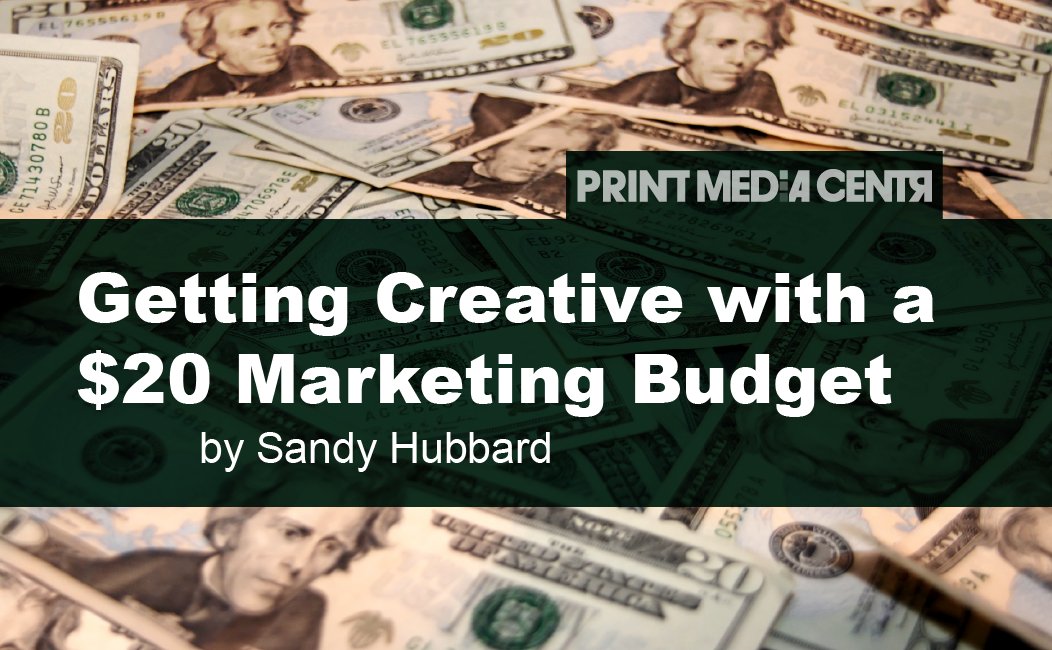Doing a small project — even one with a ridiculously cheap budget — can be a way to show customers that creative marketing gets direct, measurable results. Having some fun in the process makes you endearing and spotlights you as a preferred vendor. Helping customers make critical business decisions based on marketing input makes you invaluable.

Here’s an example:
The owner of a restaurant with two locations was at a decision point. One location had been shuttered, not due to COVID-19 but because the neighborhood had gone through a failed renaissance.
There was talk of reopening the second location on a limited basis. The owner didn’t expect the second restaurant to stay open permanently, but he did not want to miss potential business.
Since I was already doing print marketing and handling advertising for his main location, we talked about options for the second.
What is your budget, I asked?
“Twenty dollars,” he said. I laughed.
He was serious, $20.
I was ready for the challenge. We held a team meeting with the employees and came up with a very fun promotion that we scraped together from existing assets.
Here’s what we started with:
T-shirts
The chefs and wait staff at both locations had branded T-shirts in various stages of wear and “stainage.” We found about six of them that were in not-bad condition.
Hacky Sacks
I had a basket full of small balls with bells inside, knitted by my sister from colorful yarn scraps, meant as cat toys. She had tried to sell them at a craft fair with no luck. To me, they looked like mini Hacky Sacks. We raided employee closets and found a few real Hacky Sacks.
Items from previous promotions
We had an assortment of takeout menus, door hangers (some with hooks and some with rubber bands), doodads, food show souvenirs, and small unopened toys.
Next, we talked about what we could do with $20. Working with a bunch of young creative people in the food industry was eye-opening.
They have ideas and energy!
The creative stage:
These ideas were well over $20, but they had to be discussed.
- We talked about getting a permit for sidewalk seating, but the owner did not want to bank on the ability to keep the location open, so that was not “on the table,” so to speak.
- We thought of a small postcard mailing to the neighborhood, explaining when the restaurant would be open, what the limited menu would be, and a desirable offer. But again, the owner did not want to promise to stay open if the finances did not pencil out.
- I thought we could use the existing door hangers and pay people to run them around the neighborhood (thanks, Howard Larson!). The owner was worried about people in the area breaking into his location if they thought there was inventory in there.
- The owner was already running a color ad in the newspaper that performed well for the main location. We talked about modifying it, but the owner did not want to mess with success.
Here’s the final $20 marketing program:
- The second restaurant would be open on Friday after 3 p.m. until all the food was sold.
- We chose a team of 3 young employees (originally decided on for safety, but it turned out to be a good-sized group to catch attention). They would wear the (pre-worn) company T-shirts over black long-sleeved undershirts. The undershirt concept came about because of the sour residual “Restaurant B.O.” on the branded T-shirts. If you’ve ever worked in food service, you know what I mean. >.<
- The team already had their work uniform black pants, which looked great with the outfit. We bought the undershirts for less than $3 each.
- We made up a bunch of baggies with the promo stuff and the little homemade Hacky Sacks.
On the first Friday, we arrived early and parked a car out front that had a teeny trailer hooked onto it. It was a very cheap, lightweight trailer with foldable sides. Our goal was to make the kids and the storefront visible from the street.
We had the promo team with their T-shirts and Hacky Sacks wave and have a good time in front of the restaurant. One young lady was a high school gymnast and could do a standing backflip and a really high “round off,” which was quite impressive! If someone slowed down to look, the team would point to the window signs and yell for them to come back that night. If someone rolled down the window and agreed to it, the team would toss a baggie of goodies through the window. A good solution for stop and go traffic on a busy street!
[Side note: We did have a visit from a police officer who wanted to make sure we were not distributing anything illegal. And we had to comply with the rules about public spaces and sidewalks. However, he was sympathetic to the $20 budget and just told us to be safe and respectful. Also, he did not want us waving at people from on top of the trailer (which had been tried… along with a bit of showing off with the Hacky Sack). He said, “I don’t want to hear you’ve been doing that,” which was his nice way of telling us he knew.]
For motion, color, lights, and interest, we bought cheap fabric the same color as the T-shirts. We draped it over the doorway, anchored it down at the bottom, and then weaved in my own battery-operated LED Christmas lights. The display was lightweight enough that it flowed in the breeze. It was inviting and eye-catching. We adapted the idea from a garden store that had used chicken wire, gauzy netting, and lights to make an arch around their doorway. Also, my husband used to do this in my PTA days for kindergarten recruitment night. People love twinkle lights.
With the cost of the fabric, black shirts, some Dollar Store items, and the signs in the windows, we spent our budget of $20.
The first night, my client had done all the prep and cooking at the main location. The cold items were boxed, refrigerated, and ready to go. The costs were minimal: powering up the lights, cleaning before opening and through the shift, a cashier/phone answerer, and one person who managed the to-go inventory and ran orders out to the curb.
My client called it a break-even night, cost-wise, but he thought it was good for morale and it kept the employees busy at the main location.
The second week we had over a hundred customers, still using our waving hacky sack players to get attention.
At this point, I was thinking every restaurant should have a satellite location for distributing to-go orders. It seemed wildly successful to me. However, margins in the restaurant business are slim to none, and my client said it wasn’t enough to warrant the extra work.
After a few more tries, my client decided the second location was not viable. Maybe he intended to close it all along, but now he had real data to justify it.
In the end, he spent $20 to test the viability of reopening the second restaurant.
Our affordable marketing experiment helped him make an important business decision.
Next steps for marketing:
When it comes to print, my client’s existing branding and design is impeccable. Going forward, we’ve discussed:
- Every Door Direct Mail postcards (they work!)
- Door hangers (we have ‘em, let’s use ‘em!)
- Freshly printed T-shirts (please!)
- Light-permeable window clings (affordably printed by another one of my clients!)
- Updated all-weather signage for the sidewalk signs (worth paying for a permit!)
- Promotional items to reward returning customers (every customer counts!)
- Vehicle wraps or signage for vehicles (color and motion!)
- Creative ways to get menus into people’s pockets (and onto their phones!)
Takeaways:
I have done marketing strategy and execution for huge companies, non-profits, and startups with multimillion-dollar marketing budgets. Projects like the Hacky Sack experiment stand out, though, because they make a real difference for the small business owner.
When it’s all said and done, feedback from this marketing experiment made a difficult (and probably emotional) business decision easier. It opened his eyes to the talent within his own team, and it furthered his trust in me. That’s how to get creative with a $20 marketing budget!
Have you done something super creative on a very tight budget? I’d love to hear your stories. Feel free to comment below!
 Sandy Hubbard is an expert Marketing Strategist specializing in the Printing Industry. She consults with Print CEOs and owners of print, media, and platform businesses of all sizes — helping marketing teams build visibility and increase sales.
Sandy Hubbard is an expert Marketing Strategist specializing in the Printing Industry. She consults with Print CEOs and owners of print, media, and platform businesses of all sizes — helping marketing teams build visibility and increase sales.
Sandy is also co-host of #PrintChat, a weekly discussion on LinkedIn. Join the group here — and enjoy social media’s most popular chat for the global printing industry!











